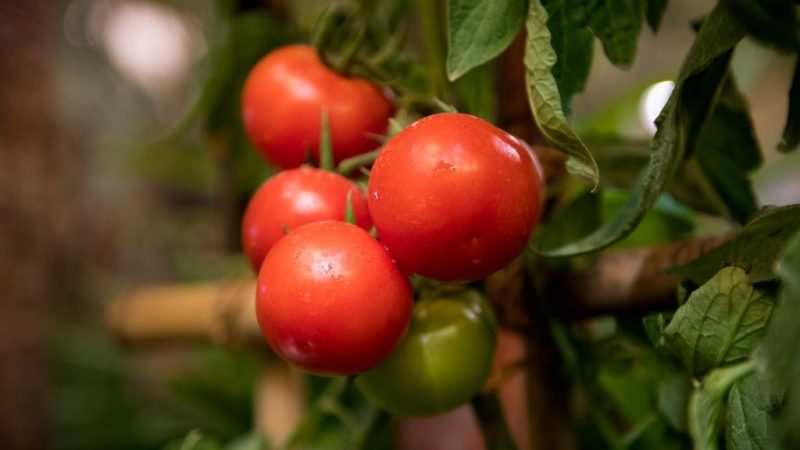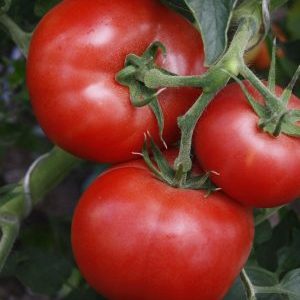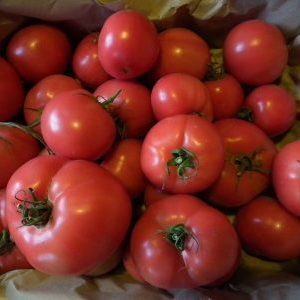Is it true that the Kukla tomato is the best variety for growing in a greenhouse?
The dream of any gardener is delicious and beautiful tomatoes. Breeders are constantly working on developing new varieties that will be unpretentious in care, resistant to diseases and will give a good harvest. The Kukla hybrid belongs to innovative crops.
The content of the article
Description and characteristics of the hybrid
Determinant Tomato Doll f1 has proven itself as an unpretentious and fruitful hybrid for growing in the open field. It was brought out by the firm "SeDeK", entered in the State Register in 2006.
Low bushes (up to 65 cm on average) are distinguished by a moderate number of shoots and small leaf size. However, with such parameters, the bushes need to be formed.
The culture is fertile, extremely resistant to tomato diseases and pests. It is grown both outdoors and in greenhouses. Several fruits of the same size ripen on one bush at the same time. The output of marketable products is complete. Up to 9 kg of vegetables are harvested from each square meter (with proper care). The yield of the Kukla hybrid is from 263 to 632 centners per hectare.
Quite large fruits (up to 400 g) are attractive in appearance: they are pink with a shiny tint. Tomatoes are fragrant, dense pulp is characterized by sugar content. Tomatoes are added to both nutritious and dietary salads. They are suitable for conservation. They are stored for a long time intact, without cracking, they tolerate transportation well.

Pros and cons of a hybrid
The undoubted advantages of tomatoes:
- Flower brushes are laid early.
- Fruits ripen faster than other varieties and hybridsthat avoids defeat late blight.
- The harvest is distinguished by high volumes and a friendly return.
- Tomato is less susceptible to diseases, unpretentious in care.
- The hybrid takes root in open and closed ground.
- The fruit has a sweet taste.
- Tomatoes are universal in use: they are used fresh, canning for the winter, they prepare juices, sauces from them.
- During storage, the fruits do not crack, they have high transportability.
Despite a number of advantages, the hybrid has minor disadvantages:
- Seeds have to be purchased annually, since the collected material does not retain the quality parameters of the hybrid.
- Low bushes still need garter.
- It is important to water the culture in a timely manner.
- The determinant form does not always suit gardeners, since the bushes stop growing after the formation of ovaries.
The limited growth of the culture does not prevent the merits from being fully manifested with the correct cultivation of the hybrid.
How to grow
Tomatoes are grown by seedling method. Sowing is carried out 1.5-2 months before transplanting into the ground. Before this, they pay attention to whether the seeds have been processed from pests and diseases by the manufacturer. This is indicated by the coating of colored granules.
If there is no treatment, the seeds are soaked in warm water for 30 minutes, wrapped in a damp cloth and left until they hatch.
Getting seedlings
Sprouted seeds are planted in prepared soil, bought in a store or prepared on their own. The composition of loose and nutritious soil includes sod land, sand, compost, black soil in a ratio of 2: 1: 1: 1.
The bottom of the tanks is drilled, a drainage layer is poured and filled with ready-made soil. Do not fill the container completely, leave 2 cm to the brim. The soil is disinfected by spilling boiling water or potassium permanganate solution. The seeds are planted to a depth of 1 cm, maintaining a distance of up to 3 cm between them.Cover with earth, watered and covered with film or glass. This will maintain optimal moisture content, and the seeds will germinate faster.
With the appearance of the first shoots, the shelter is removed, the container with young seedlings is rearranged to a lighted place... The temperature should not exceed +16 ° C. A pick into individual containers is carried out when the first 2 leaves appear. In order for the root system to strengthen and form, the seedlings are buried in the soil.
Planting tomatoes in the ground
2 weeks before planting in the soil, the prepared seedlings are hardened: they are taken out daily to fresh air, gradually increasing the time spent outside. At the time of disembarkation, the bushes should be outside the whole day.
The seedlings dive to a permanent place at the age of two months, when the plant height reaches 30 cm, and there are up to 6 leaves on the stem. Transplanted together with a lump of earth.
Reference! For growing tomatoes, they choose a sunny area where legumes, garlic, and cucumbers used to grow.
Watering and care

Get a generous and tasty harvest with proper hybrid care:
- For quick ripening of fruits, regularly stepchildren processes.
- Tomatoes are fed with complex fertilizers.
- Pay special attention to watering: The doll does not tolerate cold water, so during the day the liquid is warmed up under the sun, and in the evening the soil is moistened. Water the bushes at the root.
- The beds are regularly weeded no deeper than 10 cm: the weeds should not drown the tomato stems. To reduce the frequency of weeding, the soil is mulched with straw, sawdust or peat. The soil is periodically loosened.
- Avoid the neighborhood of culture with eggplants and peppers, especially bitter varieties.
- When the growth of the bushes reaches 1 m, they are tied up.
Caring for a hybrid is simple, but requires systematicity and thoroughness.
Prevention of diseases and pests
Hybrid Doll is resistant to tobacco mosaic and verticillium infection. However, if the summer is humid with high temperatures, the culture is subject to fungal diseases:
- stems, leaves and fruits of the culture may suffer from late blight, which manifests itself in the form of brown spots;

- greenhouse tomatoes are affected by powdery mildew, which covers the leaves with white bloom or yellowish spots;
- dry or black spots appear on both green and ripe fruits;
- wilting of the upper leaves, small dark spots on them indicate damage by anthracnose;
- septoria is characterized by small specks with a black outline, which leads to drying of the leaf system;
- gray rot is an enemy of tomato stems and fruits, often transmitted from neighboring cucumber crops. Fungicides "Baylon" and "Euparen" are used against the disease.
For the prevention and treatment of fungal diseases, plants are sprayed with special agents: "Topaz", "Strobi", "Quadris". Processing is carried out every 2 weeks 3 times.
The main pest of the Doll tomatoes is the Colorado potato beetle. Newly planted young shoots can be destroyed by it in a day. To protect the plants, they are sprayed with insecticides. Before planting, the roots of tomatoes are soaked in the Aktara solution for 2 hours (1 bag for 2 liters of water). Mature plants are more resistant to pest attacks.
Attention! Ripe fruits that have been damaged should not be sprayed. Therefore, tomatoes at the stage of milk maturity are periodically plucked and placed in containers for ripening.
Other pests of the Doll are whitefly, bear and gnawing scoop. They use "Confidor", "Thunder" and "Arrow" against them, respectively.
Reviews of gardeners
Many growers are attracted by the low growth of the hybrid - it does not take up much space. Almost everyone who leaves reviews about the Doll is amazed at the germination and yield of the crop:

Tamara, Ryazan: «A good tomato, I liked the even identical tomatoes, as in the photo, weighing 100-150 g. The taste is ordinary, with a slight sourness. The fruits are perfectly stored and are suitable for conservation. "
Valentina, Moscow region: “The fruit tastes sweet and sour tomato, the skin is strong, does not crack. Only the size of the hybrid did not impress ”.
Svetlana, Penza: “I grew the Doll in the greenhouse and in the open field. There were no problems with leaving. The brushes formed 6 fruits, identical and even. Tomatoes are hard and tasty, suitable for salads and canning. The yield is high. "
Conclusion
Tomato Doll f1 is a welcome guest on the beds of gardeners looking for early and productive crops for open ground and greenhouses. With regular care, the hybrid gives an abundance of large, beautiful fruits that are universal in cooking. 8-9 kg of tomatoes are obtained from 1 m2.
The fruits ripen early, for this reason they do not have time to become infected with late blight.